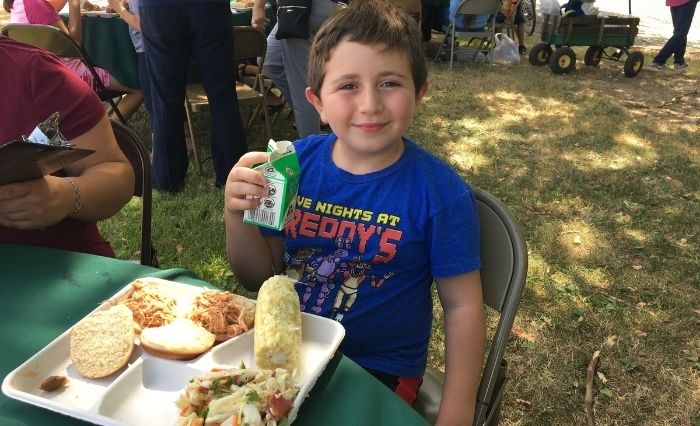By: Ashley Rosales, RDN

Everyone deserves to be healthy, and one way to support that is by ensuring all children, families and communities have access to wholesome, nutritious foods. As a registered dietitian nutritionist who has spent over a decade elevating health and wellness through nutrition education, I believe that achieving nutrition equity is one part of the solution to achieving good health for all.
Experts agree that the places where people live, learn, work, play and gather affect overall health and quality of life. These environmental conditions, known as social determinants of health, contribute to health outcomes and partially explain why some Americans are healthier than others. Even honing in on one aspect of health—nutrition—will require multisector support at all levels to ensure all people are able to access healthy foods and nutrition education, which play an important role in supporting healthier children, families and communities.
The Importance of Nutrition Equity
 Nutrition equity ensures
that all people have the ability to access nutritious and culturally appropriate foods regardless of race, education, gender, employment, ability or community. Identifying barriers and allocating resources to remove those barriers is vital to achieving
nutrition equity. Unfortunately, many children and families, especially those in marginalized communities, live with food insecurity. According to Feeding America, one in six children—roughly 13 million—is expected to need food aid this
year.
Nutrition equity ensures
that all people have the ability to access nutritious and culturally appropriate foods regardless of race, education, gender, employment, ability or community. Identifying barriers and allocating resources to remove those barriers is vital to achieving
nutrition equity. Unfortunately, many children and families, especially those in marginalized communities, live with food insecurity. According to Feeding America, one in six children—roughly 13 million—is expected to need food aid this
year.
For several decades, U.S. policies have addressed hunger and food insecurity by focusing mostly on providing enough calories and quantities of food. Today, most Americans receive enough calories, but there are still great disparities in access to nutrient-rich, affordable food, while rates of obesity and other chronic diseases continue to rise. Addressing the crisis of food insecurity is not just about ensuring people have adequate amounts of food, but that the food received is high in quality and culturally familiar. Access to nutritious, high-quality food helps people develop healthy eating patterns, which play an important role in preventing chronic diseases like obesity, diabetes, high blood pressure and heart disease, especially in marginalized communities.
Food insecurity is more than just experiencing hunger. It is linked to the lack of access to nutrient-rich foods and nutrition education, which together provide the knowledge, skills and ability to make healthier food choices. When not adequately provided, the result is reduced diet quality, which in turn can lead to poor health outcomes such as increased risk of developing diabetes or high blood pressure. Supporting access to affordable, nutrient-rich foods can close nutrient gaps that exist in the diets of many Americans. Additionally, encouraging consumption of fruit, vegetables, milk and dairy and whole grains while reducing consumption of highly processed foods that are high in calories but lacking vital nutrients will go a long way in improving overall health and well-being.
Dairy foods like milk, yogurt and cheese are nutrient-rich, affordable, accessible and culturally relevant. They offer a unique package of nutrients that work together to provide multiple health benefits, including optimal growth and development in children and reduced risk of chronic diseases in adults. Dairy foods can be incorporated into eating patterns that focus on whole, minimally processed foods such as fruits, vegetables, whole grains and lean protein, which can help improve overall nutrition. An eating pattern that is built on a variety of nutritious foods supports proper immune function, brain development and physical and emotional growth for lifelong health and success.
Supporting Nutrition Equity
 Along with ensuring affordable and accessible nutrient-rich foods and beverages, nutrition education is equally important to nutrition equity. Knowledge, combined with skills
and access, helps empower behaviors that lead to better health habits and outcomes. For example, food-tasting activities and preparing food together in the classroom, school cafeteria or home provide hands-on exploration of foods and opportunities
to build nutrition knowledge and healthy eating habits. Let’s Eat Healthy nutrition resources are free, science-based behavior change teaching tools created to help educators, health professionals and advocates teach nutrition education and
empower healthier children, families and communities. Resources like Family Connection help encourage parents and caregivers to enjoy food and
nutrition activities together.
Along with ensuring affordable and accessible nutrient-rich foods and beverages, nutrition education is equally important to nutrition equity. Knowledge, combined with skills
and access, helps empower behaviors that lead to better health habits and outcomes. For example, food-tasting activities and preparing food together in the classroom, school cafeteria or home provide hands-on exploration of foods and opportunities
to build nutrition knowledge and healthy eating habits. Let’s Eat Healthy nutrition resources are free, science-based behavior change teaching tools created to help educators, health professionals and advocates teach nutrition education and
empower healthier children, families and communities. Resources like Family Connection help encourage parents and caregivers to enjoy food and
nutrition activities together.
Addressing environmental conditions—where people live, learn, work, play and gather—will also be critical in achieving nutrition equity because these social determinants of health are interconnected with health and health outcomes for children, families and communities. There are many ways to eat healthfully, and acknowledging and embracing cultural preferences towards food choices, especially in communities of color, is also critical. Achieving nutrition equity will require collaboration among many stakeholders, including community leaders and experts in nutrition, health and education, as well as consideration of the important perspectives of the people within communities.
One way educators and health professionals can be part of the solution to improve nutrition equity is to join the Let’s Eat Healthy movement to support children and families in building healthier lives and communities. Through shared values, the movement aims to empower stakeholders to champion community health through nutrition, provide resources to inspire and enable healthy eating habits, and find solutions to make nutritious foods accessible and affordable to all of our diverse communities. Join the movement today at HealthyEating.org/Join.

Ashley Rosales, RDN
Ashley Rosales, RDN
Ashley, Nutrition Science Officer, is a practicing registered dietitian nutritionist with more than a decade of experience.
Research continues to find that eating school meals every day is associated with healthier dietary intakes among U.S. schoolchildren.

Food processing plays an important role in food security and food safety. These processing methods can impact the quality and healthfulness of food.

Subscribe to our blog to stay up to date on the latest news, products, and more.